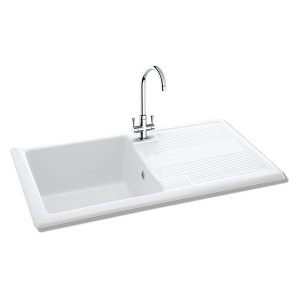Cleaning Information for Ceramic Sinks

Day to day care
Your new ceramic sink is manufactured to the highest possible standards. To maintain its good looks, Carron Phoenix suggests you follow these guidelines. Most deposits can be removed with washing up liquid and hot water followed by a clean water rinse. It is also good practice to then dry the sink with a soft cloth as otherwise limescale can build up on the surface.
The quality of your water can affect the good looks of your sink by giving the appearance of staining. This “staining” is generally a build up of limescale or similar mineral deposit, particularly prevalent in hard water areas. Limescale readily absorbs staining agents such as tea, coffee, red wine, etc., spoiling the appearance of your sink. For this reason always rinse and dry your sink after each occasion you use it to avoid mineral deposits being left behind on the surface when the water evaporates.
To remove any limescale that has built up on your sink, try using a proprietary limescale removing product such as Viakal® or Limelite®. Alternatively, soak in a solution of one part vinegar to three parts water. This will loosen the scale, making it possible to scrub it away with an abrasive pad and kitchen sink cleaner.
A fast and easy way to remove water marks, grease or soap scum deposits, is with Coloured Sink Cleaner, or with a proprietary bathroom cleaner such as Ajax or Flash liquid spray. For everyday cleaning of your ceramic sink, using a soft cloth or sponge with some mild liquid soap or any vinegar-based cleaner is ideal.
Specific problem areas and recommended treatments
Oil, grease and fingerprints
These are generally removed with washing up liquid and hot water but a solvent may be required (eg. White spirit or Methylated spirits). Care must be taken to use the proper safety precautions if using solvents.
Tea stains or vegetable juices
Likely to be stains that are clinging to mineral deposits, such as limescale, lying on the surface of the sink. See reference to mineral deposits, below.
Mineral deposits and scaling
Generally caused by build up of limescale, remove by soaking in a solution of vinegar (3 parts hot water to one part vinegar), then scrubbing the deposit away. Alternatively use a proprietary brand such as “Limelite”.
Don’t forget! – always finish off by rinsing your sink thoroughly with clean water to remove any residue, then dry it with a soft cloth to prevent limescale building up.
Cleaning tips
Take care to avoid
- Dropping sharp objects such as kitchen knives directly onto your sink. These could chip the surface.
- Dropping heavy based pans or other kitchen utensils onto your sink, especially vulnerable areas such as the rim edge, as this could result in chips or cracks.
- Leaving wet cleaning aids on the sink (such as cloths, pads, containers). As the water evaporates off, a mineral or limescale deposit is left behind on the surface.
- Using your sink to cut food. A wooden chopping board is recommended for this purpose.
- Placing hot pans on the surface of the sink. Your sink can withstand very high temperatures of up to 250ºC. Hot pans straight from the hob or oven often exceed this temperature however and could mark or cause crazing to the glaze.
- If bleach is necessary to clean the overflow or waste outlet, squirt into the hole, leave for 2-3 minutes only, then rinse thoroughly with clean water. Under no circumstances leave in contact with the surface for longer than 30 minutes as this will cause damage to the stainless steel.
- Using a plastic washing up bowl. Particles of grit or glass could become embedded in the base of the plastic bowl and these will scratch the sink.
